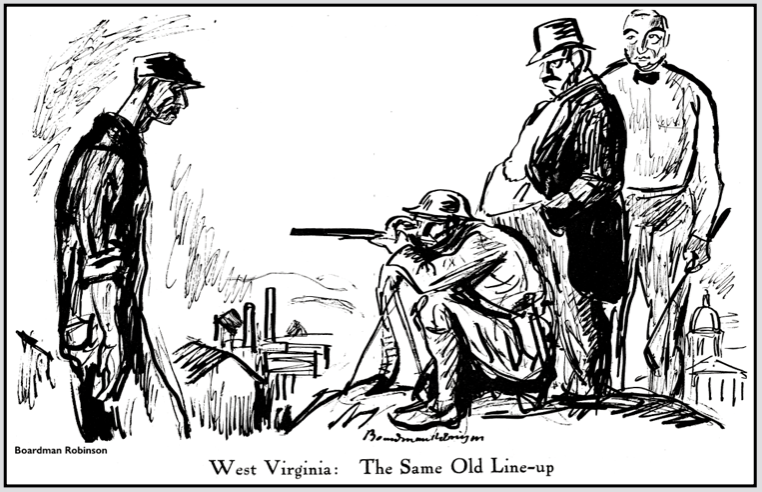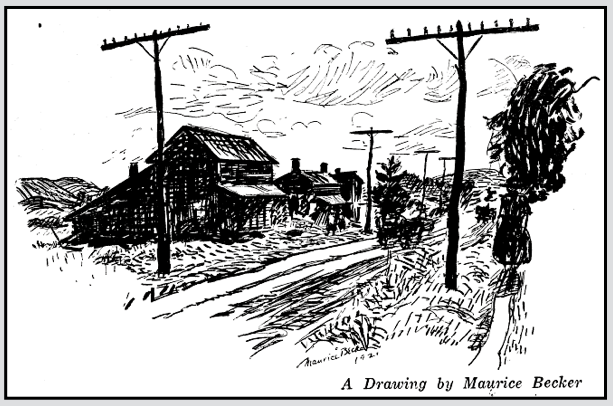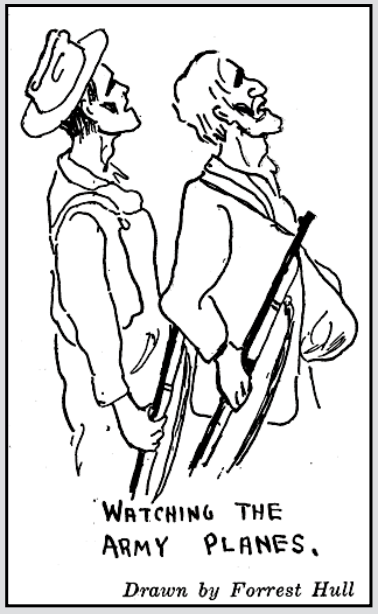 —————
—————
Hellraisers Journal – Thursday October 6, 1921
Art Shields Reports from West Virginia on Battle of Logan County
From The Liberator of October 1921:
The Battle of Logan County
By Art Shields
———-[Part II of II.]
The murder of Hatfield and Chambers in that premeditated fashion on the court house steps was the dramatic event that focused their eyes on the crisis before the whole labor movement of West Virginia. It was now or never for the cleaning up of Mingo County.
Up and down a hundred mountains where men delve deep for coal and even in the black diamond fields of Kentucky and Virginia, men began reaching for their high power rifles for the big hunt again, as in Cabin Creek days. Organization for the purpose was hastily improvised, outside of the United Mine Workers, which did not allow its district machinery to be used, and shortly after the middle of the month thousands of men began to move for the gathering place of Marmet. They came by train or car to this little town and its surrounding fields, there on the border of Boone and Kanawha counties, just sixty-five miles, as the bird flies, or more than a hundred by road, to the Mingo coal fields. The route led straight across the union grounds of Boone County and the thug-ridden lands of Logan.
Thousands of miners, black and white, came at the call: railroad men were there, atoning for the stain cast by the men who were transporting machine guns and thugs into Sheriff Don Chafin’s Logan County lands; building trades men came who knew that the powerful miners’ union held up all organized labor in West Virginia, and machinists and farmers’ boys gathered with the rest. Among the lot were more than two thousand who had taken post graduate lessons in shooting “over there.”
They moved on from Marmet on the twenty-fourth and twenty-fifth of August, some six thousand strong, with thousands more coming on behind. Auto trucks loaded with provisions went on ahead and came behind. They were a formidable force when they arrived in the little Coal River Valley town of Madison in Boone County near Logan on the twenty-sixth. But here like a wet blanket on their enthusiasm fell the discipline of the United Mine Workers. President Frank Keeney of District Seventeen, with a record of consistent hard fighting, economic and otherwise, nevertheless ordered them to go back. What President Harding’s ultimatum could not accomplish the hand of their union did.
They slowly started back, but they had not scattered far when the murderous Chafin’s forces galvanized them into a return charge that no mere orders or persuasions could have halted, had they been attempted. Four hundred Baldwin-Feltz thugs had dashed into the little mining town of Sharples, seventeen miles up the valley from Madison, Saturday night, and killed two miners, wounded two others, generally shot up the town and gotten away with four prisoners before the miners, taken by surprise, could come together from the neighboring hamlets.
The miners tumbled back into the Coal River Valley, thousands of reinforcements coming to avenge this latest insult, and the battle of Logan County began. Fighters rushed up to the front on each side, miners taking special trains on the little Coal River Railroad line and Chafin rushing in hundreds of state troopers, a thousand “killers” from McDowell County with Sheriff Bill Hatfield, recruits from Mercer and Wyoming, a few Legionaires and other volunteers from elsewhere, and two or three thousand Logan people, volunteering through fear of submitting to a conscription that was enforced with threats of death, threats backed up by at least one jail murder.
It was a battle on the miners’ part to break through the hills that cut off Boone County and the little unionized strip, from Logan, from the domain of the Baldwin-Feltz that was to furnish highway on their march to Mingo.
Machine gun nests guarded the fifteen miles of serrated mountain, and outposts of riflemen and automatic riflemen flanked out to protect the artillerymen. During the delay in the miners’ march the other side had had time to dig themselves in and set their guns to command the mountain passes.
Cleaning out these machine gun nests and dislodging snipers was the imperative job of the miners’ forces from the, start. Out of the ten thousand men the best shots were picked for long distance elimination work while telescopes, searched out the machine gun centers.
Sometimes one of the rapid fire mechanisms was placed so carefully that snipers had no chance to get results, and the gun had to be taken by storm, or not at all. If you will climb the mountains some miles from Sharples you will come across a small field of corn that has been mowed, as, by a scythe, by machine gun fire. A squad of volunteers from the labor army dashing up the hill found that the gunner was unable to depress his weapon below a certain angle, and by bending double the shot went over their heads, harmless to everything except the mountaineer’s corn patch. This machine gun and four others near by were captured and two more elsewhere. Others were dragged back to second bases as the fire became too hot in the last days of the battle. All along the line, from Hewitt Creek at the lower end of the valley, up through the mountains till within a few miles of the extreme end line, the workers’ forces crowded their enemy back. Whenever the holding of the line depended on the conscript forces that line was not held, as in the midsection of the line where fifty conscripts with a few Baldwin men mixed in hurriedly deserted an abandoned house in which they were camping for the night, at the rumor that the miners were coming. When the miners came they found a medley of trousers and socks and shirts left behind by some who fled too hastily to dress.
But it must not be supposed that most of the regular gunmen and the state troopers were of such weak kidney, “Give the devil his due,” said one of the worker-fighters in telling me of their desperate resistance. “Our boys got within twenty yards of a trench near George’s Creek there, and those thugs stood their ground. Some of them couldn’t shoot well, or our men wouldn’t be alive, but they were game all right.”
Some of them could shoot, too. I saw a tall tree whence a sniper had done execution till a rifle bullet tumbled him ninety feet to the ground.
Sheriff Chafin lost one of his chief aides in the fighting near Blair, a veteran gunman named John Gore, who earned several paragraphs of eulogy from the newspapers when his death was announced. Gore fell with a bullet in his head while he was leading an outpost near George’s Creek behind Blair Mountain, just after he had sent a ball through a chestnut tree killing a Negro.
In the same section of the fighting zone another bullet nearly clipped that very C. E. Lively who murdered Ed Chambers on the court house steps, if the eyes of a miner who knew him well did not deceive him. This miner was in charge of a body of men that had just fallen back to shelter after an attack on a trench, when he suddenly shouted, “There’s that scoundrel” and drove a chunk of lead through the bark of a tree behind which a man was operating with an automatic gun.
The Chafin forces were about as numerous as the miners, but composed of assorted gunmen, volunteers and conscripts, they were not nearly as effective as the miners, in spite of superior equipment. Consequently they lost many times more men. The miners have a record of eight known dead and several missing on their side, whereas the reports of refugees from Logan who counted stacks of dead brought back in truck loads from the front, make it evident that one to three hundred lives were lost on the other side.
Apparently it was the disaster that was overtaking his forces that caused Chafin to loose his two borrowed planes as bomb droppers. For the first few days they had been doing scout duty only, but Thursday, September 1, hastily constructed bombs, made of powder and iron nuts stuffed into thirty inches of six-inch gas piping were supplied to the aviators. Bottles with chlorine gas were carried in addition and the mechanical hawks shot over the hills to the mining villages. The first bomb, dropped near Jeffrey, fell between two women washing their clothes, Mrs. Sallie Polly and Mrs. Lizzie Oxley, her married daughter. Like most of the others it was made so clumsily that it struck wrong and failed to explode. For three days bombs dropped on all the little mining towns in the valley, from Jeffrey, south to Blair. Mrs. Dula Chambers, the wife of the village blacksmith of Jeffrey, was gassed by a bursting bottle as she was rushing on a Red Cross automobile to the emergency hospital in a school house six miles up Hewit Creek from Jeffrey, and she was sick for two days. But for the most part the bombs represented only the most futile bungling as well as brutality of intention.
The arrival of the federal troops, whom they summoned saved these latter day West Virginia beasts from the hands of the men they had wronged. Don Chafin still rules and lives by murder in his stronghold in Logan and the coal operators of the southwest counties are getting out their non-union coal at half wages and without the usual safety appliances. Nevertheless all is not well with them. The effect of the battle of Logan County has been to inspire the miners of the union counties with greater spirit and determination and it is tending to bring the whole labor movement of the state into closer co-operation.
—————
~~~~~~~~~~~~~~~~~~~~
SOURCES & IMAGES
Quote EVD Wlg WV Oct 24, Wlg Dly Int p2, Oct 25, 1900
https://chroniclingamerica.loc.gov/lccn/sn84026844/1900-10-25/ed-1/seq-2/
The Liberator
(New York, New York)
-Oct 1921, Part II, page 17
https://www.marxists.org/history/usa/culture/pubs/liberator/1921/10/v04n10-w43-oct-1921-liberator.pdf
See also:
Hellraisers Journal: From The Liberator:
“The Battle of Logan County”-Art Shields Reports from West Virginia, Part I
re William Forrest Hull
https://www.findagrave.com/memorial/67103949/william-forrest-hull
Tag: Battle of Blair Mountain 1921
https://weneverforget.org/tag/battle-of-blair-mountain-1921/
Tag: Mingo County Coal Miners Strike of 1920-1922
https://weneverforget.org/tag/mingo-county-coal-miners-strike-of-1920-1922/
Tag: Sid Hatfield
https://weneverforget.org/tag/sid-hatfield/
~~~~~~~~~~~~~~~~~~~~~~~~~~~~~~~~~~~~~~~~
Battle of Blair Mountain – Louise Mosrie



